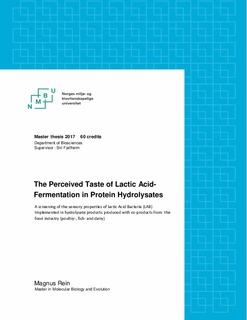| dc.contributor.advisor | Fjellheim, Siri | |
| dc.contributor.advisor | Lindberg, Diana | |
| dc.contributor.advisor | Axelsson, Lars | |
| dc.contributor.author | Rein, Magnus | |
| dc.date.accessioned | 2018-08-21T13:15:58Z | |
| dc.date.available | 2018-08-21T13:15:58Z | |
| dc.date.issued | 2018 | |
| dc.identifier.uri | http://hdl.handle.net/11250/2558736 | |
| dc.description.abstract | The use of enzymatic protein hydrolysis is today common practise within the food industry to extract additional high quality nutritional components, however the method is rather limitedly used towards products for later human consumption. The most limiting factors prohibiting a successful implementation of hydrolysates as a sustainable protein food source is the challenging sensory properties perceived by such products, whereof bitterness is a major challenge in hydrolysates from fish and whey. Small peptides with hydrophobic amino acids in key positions are often related to the perception of Bitter flavours. At the same time lactic acid bacteria (LAB) are used to refine flavours in different food products, with the capabilities to metabolize certain sized peptides. The industrial use of LAB raised the question; can LAB be used as a foodmodifier of protein hydrolysates, and furthermore can they provide the perception of improved flavours? | nb_NO |
| dc.description.abstract | Bruken av enzymatisk protein hydrolyse er i dag vanlig praksis innen næringsmiddelindustrien for å videre utvinne høyverdige næringsmiddelkomponenter. Imidligtid er bruken av metoden relativt begrenset for produkter som senere går til menneskelig konsum. De mest begrensende faktorene som motvirker en vellykket implementering av hydrolysater som en bærekraftig proteinmatskilde, er de utfordrende sensoriske egenskapene som oppfattes av slike produkter, hvorav bitterhet er en stor utfordring i hydrolysater fra fisk og myse. Små peptider med hydrofobe aminosyrer i nøkkelposisjoner er ofte relatert til oppfatningen av bittre smaker. Samtidig brukes melkesyrebakterier (“lactic acid bacteria” LAB) industrielt til å påvirke smak i forskjellige matvarer, med evnen til å metabolisere bestemte peptider. Den industrielle bruken av LAB hevet spørsmålet; kan LAB brukes som matmodifikator av proteinhydrolysater, og kan de også gi oppfatning av forbedrede smaker? | nb_NO |
| dc.description.sponsorship | NOFIMA AS | nb_NO |
| dc.language.iso | eng | nb_NO |
| dc.publisher | Norwegian University of Life Sciences, Ås | nb_NO |
| dc.rights | Attribution-NonCommercial-NoDerivatives 4.0 Internasjonal | * |
| dc.rights.uri | http://creativecommons.org/licenses/by-nc-nd/4.0/deed.no | * |
| dc.subject | Lactic acid bacteria | nb_NO |
| dc.subject | Enzymatic protein hydrolysis | nb_NO |
| dc.subject | Sensorikk | nb_NO |
| dc.title | The perceived taste of lactic acid fermentation in protein hydrolysates : a screening of the sensory properties of lactic acid bacteria (LAB) implemented in hydrolysate products produced with co-products from the food industry (poultry-, fish- and dairy) | nb_NO |
| dc.type | Master thesis | nb_NO |
| dc.description.version | submittedVersion | nb_NO |
| dc.source.pagenumber | 87 | nb_NO |
| dc.description.localcode | M-BIOL | nb_NO |

